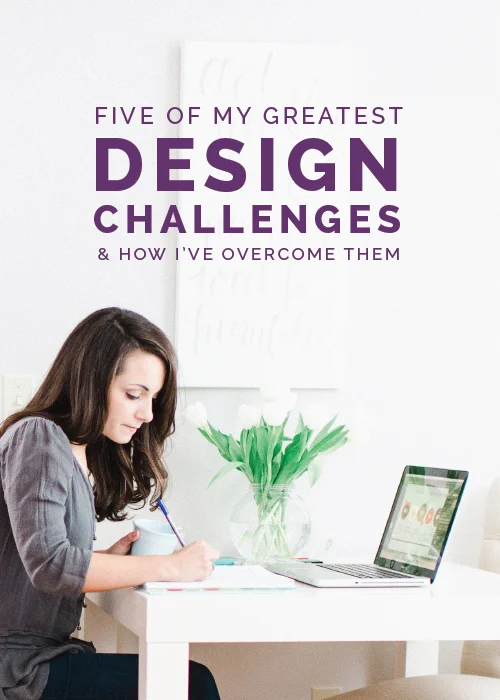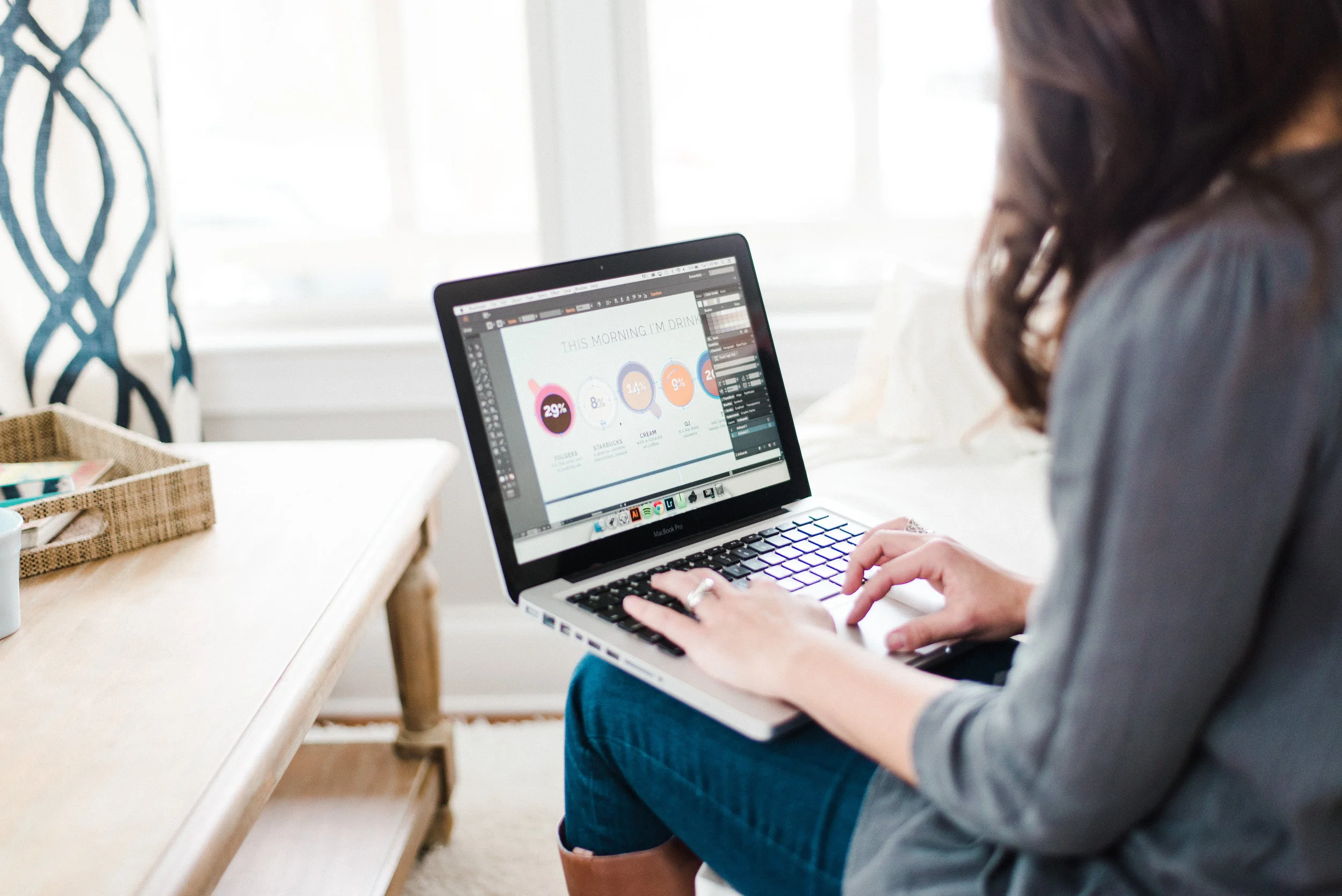One of our favorite insights from last week’s reader survey was reading about the areas that we could improve on in our blog and business. Many of you had some great constructive criticism and an even greater number of you requested posts on specific topics, like the challenges I’ve faced as a designer, blogger, and creative entrepreneur.
So today I’m jumping in and getting a little more personal by sharing some of the greatest design obstacles I’ve experienced both in design school and in business. You may not be a designer yourself, but I hope that you’ll be able to relate to these challenges in some shape or form.
1 | Finding my own aesthetic
This seems to be a common struggle for most designers, bloggers, and creative entrepreneurs alike. With so many talented, creative people in our industries, it’s easy to look too closely at others’ designs and try to either emulate them or beat ourselves up when we can’t make our work look quite like theirs.
My struggle with this goes back to design school. There was one guy in our small visual communication design program whose work stood out among the rest. He was incredibly talented in typography, illustration, packaging design, and figure drawing, and everything seemed to come naturally to him.
His edgy, illustrative style was envied by every peer and praised by every professor, and I found myself trying to mimic his aesthetic. It’s laughable looking back at it now, because if you’ve been on this website for longer than 2 seconds you know that my style is far from edgy. It’s no surprise that I failed miserably and missed out on honing in on my own design aesthetic in the process.
I’ve learned that there’s a large difference in admiring someone’s work and trying to emulate it. There are numerous designers, bloggers, and creatives out there whose work I admire, but I could never achieve their style, and that’s okay. I had to come to terms with the fact that I may not be able to do “edgy” and “modern,” but I can definitely do feminine, bright, and illustrative.
Now when I design, both for Elle & Company and for my clients, I’m very selective with the images I use for inspiration. I ask my clients to refrain from pinning images of other brands and websites on their inspiration board for fear that I’ll be tempted to follow those designs too closely and try to mimic another designer’s aesthetic.
I like to stay in my own little bubble within Adobe Illustrator and just experiment, playing around with fonts, colors, and illustrations that are visually appealing to me. If it feels like I’m trying too hard, I step back and reevaluate. While boxing myself off from other designs out there makes it more challenging, it’s more rewarding in the long run and my work is much more reflective of my own distinct design aesthetic.
2 | Separating myself from constructive criticism
Because design can be so personal, it’s hard not to take constructive criticism personally.
This, again, goes back to design school when I would spend countless hours designing a project only to have it ripped apart in a class critique. I would get extremely discouraged and question my abilities as a designer, and there was even a time when I considered switching my major to accounting because I struggled with constructive criticism (a special thank you to my older sister, Allyson, for talking me out of that one!).
It took a handful of years, but I’ve been able to separate myself from constructive criticism by realizing that while my designs are made by me, they aren’t for me - they’re for my clients. I’ve also seen how honest feedback pushes me to create my best work and revisit some areas of a design that could use a little extra finesse.
This isn’t to say that there aren’t circumstances where I need to educate my clients or explain my design decisions, but I’ve realized how important it is to keep my emotions out of it in order to arrive at an outcome that my pleases my client. Constructive criticism is a necessary part of the process and it’s crucial to getting better and improving in your field.
3 | Accepting that done is better than perfect
I’m a bit of a perfectionist. And while that’s a good thing to a certain extent, it can be also be a hindrance; it’s often difficult to find a stopping point within a project because I’m always focusing on what could be done better.
I’ve always despised the saying “done is better than perfect” because I’ve held onto the hope that it’s possible to achieve both “done” and “perfect”, but the longer I’m in business the more I realize that things can always be reworked and refined.
And yet again, this is where my 2-week design process comes in handy. The strict timeline forces me to crank out work and find a stopping point for each step within a project. And as much as I cringed at the phrase before, I’ve learned to embrace the saying “done is better than perfect.” There’s no such thing as perfect, anyway.
4 | Refraining from redesigning my brand and my site on a regular basis
The trouble with being a designer is that I’m capable of easily making tweaks and changes to my branding and my website. And while this is also a benefit of being designer, it’s very tempting to make rash design decisions and alter brand consistency by changing things up too often.
I find it especially tempting to switch things up after I launch a new brand and website project for a client; I know it was a success when their fresh new look gets me itching to switch things up with mine (like last Thursday).
To combat this problem, I’ve resolved to only make large updates once (max twice) a year to maintain consistency and really put time and effort into design decisions.
5 | Dealing with copycats
While many of the challenges on this list have taken place in the past, dealing with copycats this has been a very recent struggle for me. Through anonymous tips and thoughtful emails from colleagues and readers, we’ve discovered several people who have stolen and mimicked Elle & Company graphics and even some who have taken the files from the Library and tried to sell them in their own online shop.
And as many times as I’ve been told that copying is the greatest form of flattery, it’s often frustrating and defeating to have others blatantly copy (and even steal) your work, especially after striving hard to develop and embrace your own distinct style.
But the frustration has turned into genuine concern and sympathy for those who feel compelled to copy. Because in the time it took them to copy me or lift my graphics, they could have been honing in on their own unique style and developing an aesthetic that was remarkable and one-of-a-kind.
I’ve also channeled some of that frustration into funny infographics, like this one that I shared on the blog a few months ago!
Surely I’m not the only one who has struggled with finding my aesthetic, separating myself from constructive criticism, accepting that done is better than perfect, refraining from redesigning my brand and website on a regular basis, and dealing with copycats. One of my favorite things about the blog, especially in the recent weeks, has been the feedback that many of you have been leaving in the comments. So I want to know…
What have been some of your greatest design challenges and how have you overcome them? Can you relate to any of the struggles I listed above?
Photo credit Andrea Pesce Photography



















